|
After the flax was harvested it took considerable effort and a number of specialized tools to separate the fibers from the flax plant in order to spin it into linen thread.
|
 |
Flax Ripple
Once dry, the flax was rippled to remove the valuable seed heads. Some of the seed was set aside for planting next year and the rest was pressed for linseed oil. The leftover cakes of pressed seed were used for cattle feed.
|
|
|
|
|
The four pictured ripples all preform the same function. The massive ripple on the left is almost 3 feet long and a foot wide. The ripple with wooden tines is as we found it, tines broken and snapped off. This is a restoration project for warmer months. We picked it up as it was the only wooden tined ripple we had seen.
|
|
Retting broke down the plant structure to separate the fiber from the inner core or boon. Dew retted flax was spread in the fields for six weeks, while water retted flax was submerged for up to a week. Dew retted flax has a grayish color, but water retted flax is a light blonde color, hence the old term flaxen haired maiden. The retting process introduces microorganisms that help break down the plant structure. A crop that was over retted would disintegrate in the hetchels and be worthless for fiber.
After retting the plants were once again put out to dry. A flax break or brake was used to break the inner core or boon of the flax plant into pieces that would readily drop away from the fibers. A scutching (wooden) sword and board helped scrape away the boon before combing with the hetchels.
|
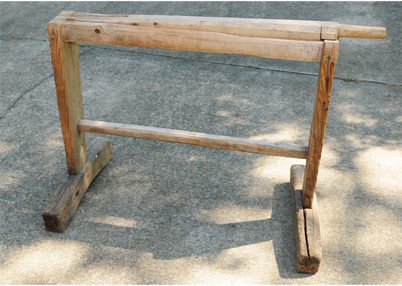
Flax Break
The wooden item is a flax break. A flax break is a set of intersecting wooden blades that force the retted flax straw to snap into short sections which then fall away from the fibers. Our break has two blades pointing down and three pointing up. Flax is "broken" when forced to bend into the shape of a W. A central pith-like core falls from the stalk. Usable flax fibers are on the outside of this central core much like fibers in celery stalks. Flax must be properly retted for this stage to be accomplished properly.
Elizabeth purchased her flax break in New York. Our break has a few splits which need repair and we need to replace the hinge pin.
|
|
Elizabeth is shown here breaking some of her flax. Some breaks have a large and heavy head which can be used to crush the fibers prior to using the break as shown.
|
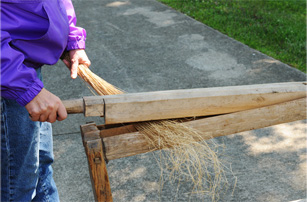 |
|

Scutching Swords
|
|
|

Flax Hatchel or Hetchel
|
Hetchels were bolted to a work surface in a series from coarse to fine. The bundle of fibers are flipped over the teeth and pulled though, much the same as combing hair. A flax dresser who could gain the largest amount of spinable fiber from a crop of flax was very highly paid.
Click here to see more flax combs.
|
Sometimes the flax would be roughly hetcheled and then twisted into a knot and put away into an attic to dry further, thus resulting in even finer flax fibers. Knots or stricks of flax could also be sold as a cash crop.
Fiber left in the hetchels is called tow and was collected and spun to make rough clothing or sacks. Tow was also used as tinder to start fires or used in guns.
|
|
Elizabeth discusses spinning flax with a spinner at Mannings in Pennsylvania.
The spinner is drawing down flax fibers that have been dressed on her distaff.
|
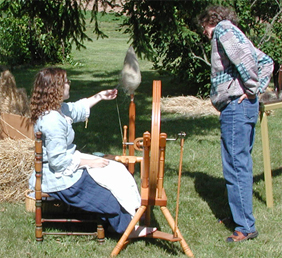 |
|
Traditionally the long flax fibers were dressed on a distaff. Distaffs vary from a long pole to the cage model shown above.
When spinning the flax fibers, a spinster would wet her fingers and smooth the errant ends. After spinning, the term linen is used, or more specifically flax linen. Linen is a spun bast fiber. In early America, hemp was used more than flax because of the amount of fiber that could be obtained from a plant. (Factoid: The Declaration of Independence is written on a hemp based paper.)
From the planting of the seed to the wearing of the shirt could take more than a year or two. Since the flax fiber are up to three feet long, the cloth wears better than the shorter one-inch cotton fiber fabrics.
|
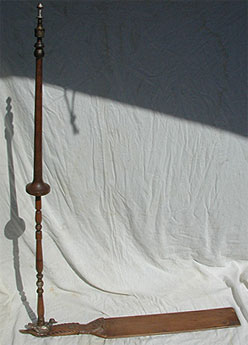
Distaff
The word "dis" means flax while "staff" means stick. These words combined--distaff--means a stick used to support flax which has been combed and now ready for spinning.
Spinning flax is generally associated with work of women and for centuries all women, regardless of status, spun. They spun when ever they had an idle moment. When one says they are from the distaff side of a family, it implies they are from the woman's side.
|
The bundle of prepared flax fibers were tied to the finial on the top. This keeps the almost three-foot fibers from tangling during the spinning process. While many flax spinning wheels have a built-in distaff, this creation permits the spinner to sit on the flat board and position the flax in a most comfortable and efficient location. While this particular distaff may be ornate, some versions are nothing more than a tree branch. A set of initials are carved in front of the duck indicating that this may have been a gift between a man and his true love.
|
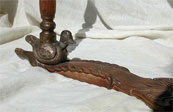 |
|
|
|